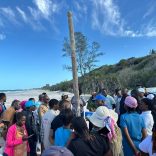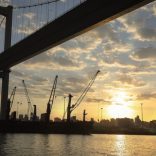Mozambique: Environmental impact of mining will take time to heal in Manica province - National ...
Mozambique: Cyclone Eloise brings flooding – By Joseph Hanlon

A video grab made from a handout aerial video footage taken by Unicef on January 24, 2021 shows widespread flooding in the Buzi are of Mozambique after the landfall of Cyclone Eloise. [Picture: Bruno Pedro | UNICEF | AF]
Cyclone Eloise hit Beira and Buzi Saturday morning (23 Jan) with 120 km/h winds. The cyclone passed south-west and is now a tropical storm in South Africa. Six people have been killed.
Heavy rain of more than 200 mm caused the major problems. On Friday afternoon the cyclone skirted the coast of Zambezia, causing flooding in coastal districts from Quelimane to Chinde. Parts of Beira were flooded and electricity and mobile telephone services were cut for a day, but are now back on. The only road into Beira, the N6 from Zimbabwe and Chimoio to Beira, remained open.
Mozambique is reeling from Cyclone Eloise which has brought heavy rains and floods and has caused thousands to be displaced pic.twitter.com/Sa7VXpACkN
— TRT World Now (@TRTWorldNow) January 25, 2021
Three rivers were already high. Flooding has been exacerbated by the heavy rains from Eloise, and flooding will continue for several more days. From south to north:
Save River on the boundary between Inhambane and Sofala was already 1 metre above flood level on Friday (22 Jan), before Eloise, and some riverside villages are flooded. The only bridge crossing the river, on the N1, is closed for repairs, and a temporary bypass bridge built. It was closed on Friday when a section of the temporary bridge was washed out. Water reached 2 m above flood level yesterday, and continued flooding is predicted. It has been possible to open the old under-repair bridge to a single lane of traffic.
Buzi River has been 2 metres above flood level since Tuesday 19 January and we showed film of the flooding on Wednesday in our previous bulletin on http://bit.ly/BuziFlood1. Buzi is still flooded and the only road access is still under water. The Public works ministry in its daily Boletim Hidrológico Nacional said roads are flooded in the headwaters of the Buzi river in Manica province.
Pungoe River this morning (25 Jan) was 2.7 metres above flood level and some side roads in Nhamatanda district are flooded, but the main N6 is open. Less Eloise rain fell over the Pungoe basin.
In Buzi town hundreds of families were evacuated on Thursday because of flooding. In Beira thousnds of people were evacuated from the most flood prone areas and spent Saturday night sleeping in schools. INGD reports that 5082 people were evacuated before Eloise struck. Six people are known to have died, four in Beira when their houses collapsed on top of them, and two in Buzi. So far 2435 houses are known to have been destroyed, and that number will increase.
Elsewhere, the Limpopo River is at flood levels and this could increase with the heavy rains in South Africa from Eloise.
INGC has recently been transformed into the National Institute to Manage Disaster Risk Reduction (Instituto Nacional de Gestão e Redução do Risco de Desastres) – INGD – https://www.facebook.com/INGD.Mocambique/ There is as yet no web page.
INGD and OCHA daily reports and Boletim Hidrológico Nacional are posted on http://bit.ly/Moz-flood21
The EU Copernicus Emergency Management Service has rainfall and flooding forecasting maps on https://www.globalfloods.eu/glofas-forecasting/ or https://www.globalfloods.eu/ and click on Map Viewer.
There have been a series of false videos alleged to be Eloise damage, but really a US tornado, Australian hailstones, South Africa in 2013, etc.
- Further to a comment, from economist Roberto Tibana
No protest from a middle class that feeds off the corrupt elite
The Mozambique “middle class” you are talking about in your Comment last week “Will this [Covid-19 explosion] trigger middle class worries?” (http://bit.ly/Moz-517) is not an entrepreneurial middle class that has stakes in the economy and social stability and abhors corruption. It is one that feeds off the corrupt state.
Many doctors, teachers, and engineers in Asian and Latin American upper or middle income countries are middle class with stakes and thus motivation and clout to push for change. Here in Mozambique they live on the verge of poverty, not far above the poverty line, and they can easily fall below it. They do not have a “subsistence reserve” to sustain the fight. They are nearly as “hand-to-mouth” as the poor (although not as near to the absolutely poor).
Most of those far above the poverty line are corrupt themselves, or servants to the corrupt elite. They do not represent the kind of middle class that can challenge the corrupt elite. They see such fight as undesirable and threatening to their short term interests. Many see those taking on the corrupt establishment as an enemy who threatens the favours they get from their corrupt masters.
I suspect that if any challenge to the corrupt elite will come it will be from the very bottom, when those people who really have nothing to lose (including their own lives!) say: enough is enough! The problem with that is that there will be a dangerous leadership vacuum, no leaders to channel their forces in a constructive direction.
The Pandemic is driving the tolerance of those at the bottom to the breaking point. On the day following the announcement earlier this month of new measures to tighten prevention, there was rioting in Manhiça district, Maputo province. Protesters burned tyres and said they could not take it any more. They wanted to earn their livelihoods; they said the preferred to die of Covid-19 rather than from hunger sitting at home. The demonstration was quickly crushed. But I am not sure this will always be the case. Certainly it could not be sustained when the government fails to pay police salaries.
To enforce Covid-19 restrictions on 15 January, a brutal and poorly educated police force was unleashed to grab vendors’ goods, particularly alcohol, in the “barracas” (informal market stalls) while beating the owners.
I know cases where people paid more than equivalent of $1000 to be taken into the police force. It is a business being in the police force. They would not use that money to pay school fees for their own skills training for other types of occupations. This is known at the highest levels of the command chain. The returns are higher as a policeman/women, not only for the rank-and-file but also for the commanders above them.
But for how long can they deliberately turn the police against the citizens in such a barbaric manner? One day there is going to be nothing in the “barracas” for the police to take. That day will be the day of reckoning for all. RJT
By Joseph Hanlon












Leave a Reply
Be the First to Comment!
You must be logged in to post a comment.
You must be logged in to post a comment.